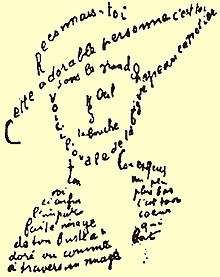Calligram
A calligram is text arranged in such a way that it forms a thematically related image. It can be a poem, a phrase, a portion of scripture, or a single word; the visual arrangement can rely on certain use of the typeface, calligraphy or handwriting, for instance along non-parallel and curved text lines, or in shaped paragraphs. The image created by the words illustrates the text by expressing visually what it says, or something closely associated; it can also, on purpose, show something contradictory with the text or otherwise be misleading.

Guillaume Apollinaire was a famous calligram writer and author of a book of poems called Calligrammes.
Visual Artist Mirjam Polman makes calligrams in which hundreds or even thousands of handwritten words are processed into art.
Gallery
 Calligram of a tiger in Arabic script
Calligram of a tiger in Arabic script.svg.png) Calligram of a snake in Georgian script
Calligram of a snake in Georgian script- Calligram about the Eiffel Tower by Guillaume Apollinaire
.jpg) Biggest Calligram in the World, part of the permanent exhibition of the Valencian Museum of Ethnology.
Biggest Calligram in the World, part of the permanent exhibition of the Valencian Museum of Ethnology.- In 1834 a French court ordered the satiric newspaper Le Charivari to publish on its front page a judgement entered against it for having carried a drawing of King Louis-Philippe in the shape of a pear. The newspaper printed the document as instructed—but in the shape of a pear.
References
- Sonja A.J. Neef: Kalligramme. Zur Medialität einer Schrift. Anhand von Paul van Ostaijens "De feesten van angst en pijn". Amsterdam: ASCA Press 2000
- Deme, Zoltan: Poem-miniatures. In: Chords of Scales, Globe Publish House 1995. Library of Congress No: 2003278749
- Post-War Japanese Poetry (with many Japanese calligrams), Penguin Books, 1972.